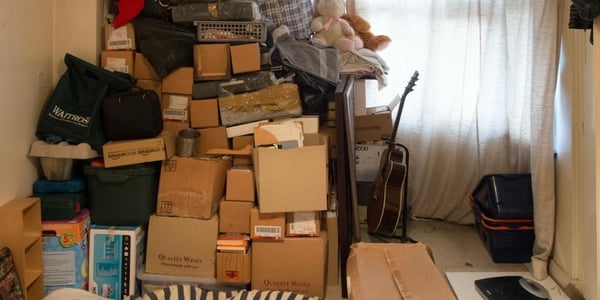As we age, many of us find ourselves surrounded by decades of accumulated belongings. Downsizing...


As we age, many of us find ourselves surrounded by decades of accumulated belongings. Downsizing...

You are likely familiar with the old saying, "messy closet, messy life." This adage implies that...

Holding onto sentimental items is a common human experience. Whether it's a stack of old letters, a...

Whether you're moving out into a smaller place or if your kids have flown the nest, choosing to...
Preparing for Your Next Move: What You Need to Know
Moving in your younger years probably meant simply recruiting a pickup truck-owning friend with the promise of pizza and beer. Now past age 50, moving takes on a bit more complexity. It requires forethought and planning to reduce the chance of a stressful experience. In this post, we'll cover four phases for making a move:
Planning the Move
Everybody's moving situation differs. Yours might be:
Whatever your unique situation, a well-thought-out moving plan is essential. These tips will help in the planning phase.
Learn About the New Location
Learn about the local resources in the new geography that could be useful during your move. For example, knowing the location of the closest Target or Walmart and local grocery, hardware, and drug stores will be helpful from Day One. Also, learn the local rules about moving trucks and parking to avoid unnecessary hassles once your stuff arrives.
Storage Unit or No Storage Unit?
Consider the possibility of using a storage unit temporarily. Renting a storage unit might be necessary if some of your belongings need to be out of the old home to stage it for sale better. Also, depending on your timeline, you may not have enough time to go through the downsizing process properly. Placing items in storage will buy time until you have the bandwidth to go through things. In either case, research storage options and pricing early in the planning cycle to avoid a last-minute rush.
What's Your Budget?
A long-distance move can cost around $5,000, and a local move $1,000. If you're doing it yourself or handling the packing, investigate the cost of truck rental, protective padding, boxes, tape, and other supplies. Remember to keep track of expenses since some might be tax deductible.
Choosing a Mover – DIY or Professional?
The older we get, the less we want to undertake a do-it-yourself move. Perhaps you're lucky enough to know willing young relatives or friends with trucks. For most of us, though, hiring a professional mover makes sense. The challenges are to find the right mover and work effectively with that company.
Click here or the button below to view TopLine Financial Credit Union's low home equity rates.
Downsizing
In many cases of moving after 50 years old, going to a residence with less square footage is common. Unfortunately, this implies that all your "stuff" won't fit in the new place. Therefore, you will need to initiate a downsizing project. Below are guidelines for making this process less daunting.
Plan Your Attack
There are four options for dealing with your stuff:
First of all, however, figure out the amount of downsizing needed. Knowing the exact measurements of your new place will help determine if large items like furniture will fit. Also, think about the lifestyle you desire in your new home. Do you feel like you are overloaded with stuff in your current home? If so, this may be an opportunity to streamline your living space to create a more peaceful and inviting environment.
Downsize Over Time
If you anticipate moving in the future, consider modest downsizing sprints over time. For example, one tactic would be to pretend you're moving every five years and go through things with that thought in mind.
Tag Items for Expiration
We often neglect to get rid of stuff due to a "you never know" attitude. Unfortunately, this leads to a "you never throw" reality. One antidote to this cruel cycle is to tag items with an "expiration date." When you pick up an item, affix a strip of masking tape with a date in the future and the words "dispose after this date." Then, when you pick up the item in the future, and it's past the expiration date, get rid of it.
Memorabilia
Let's be honest; there are some prized possessions you will never give up as long as you live. You may intend to pass these down, but your relatives and friends may or may not value them the same way. Consider offering the items to your loved ones now, along with a written description of why the things are meaningful to you. If they say yes, there’s a chance they can take the items right away. Otherwise, you may need to store the items until they can take possession. On the other hand, if they are not interested and you still can't let go, keep the written information with the item so people in the future know what the object meant to you before they toss it.
A Thousand Words…
Sometimes, we keep an item simply for the sake of good memories. One way to preserve the memory is to take a picture of the item before disposal. That way, you'll have a visual record of the cherished item.
Furniture
Downsizing furniture can be a headache due to size. Here are several tactics to handle these larger items:
For most things, the objective would be to have the receiving party do the hauling for free or at a low cost.
Move Now, Sort Later
Sometimes, circumstances don't allow for a proper downsizing before moving. While this adds extra moving and/or storage costs, it is occasionally unavoidable.
Other Pre-Moving Day Preparations
Keep in Touch with the Movers
Confirm dates and pricing with the mover in the weeks before the big day. Make sure to know when and how the mover expects to be paid, whether by credit card, check, or cash.
Packing and Unpacking
Packing and unpacking are the two most significant tasks you'll take on in moving. Of the two, packing is typically the more time-consuming. So not only do you need to pack your things carefully, but you also need a game plan for doing the job logically. Here are some packing priorities:
If feasible, you'll need to move these items yourself or arrange for safe disposal as appropriate:
Tell People Where You're Going
Now is the time to make address changes, schedule mail forwarding, and prepare to end services like refuse pickup, landscaping, and house cleaning. In addition, notify utility companies of your move to transfer service to your new residence.
Arrange for a Pet Sitter
As much as we love our pets, they can be a distraction on moving day. Also, animals can experience anxiety when their familiar environment is disturbed. Find a pet sitter who can watch your pets on the big day.
Schedule Time for Cleaning
Once the home has been emptied on moving day, don't underestimate the cleaning tasks that follow. Suppose you're moving out of a rental unit. In that case, the return of your damage deposit may be contingent on the quality of the cleaning job. It may make sense to hire someone to handle this task so you can focus on getting your belongings unpacked at the new residence.
Moving Day
The big day has finally arrived when all your careful planning will pay off. Here are some ideas to make that day go as smoothly as possible.
Final Packing – Essentials
Pack all the daily items, such as a few days of clothing, toiletries, and medications. Also, consider packing a box with moving day essentials like tools, paper towels, bottled water, toilet paper, hand soap, cleaning supplies, scissors, and box cutters.
Visit the ATM
Having some cash at the ready can help solve some unanticipated issues. For example, you can send someone to the store to buy essential items that otherwise slow down moving day momentum. Also, if you're using professional movers, you'll want to have cash for a tip. The customary rate is from 10-20%.
Place Protective Materials
Moving can be hard on a home's interior. Cover the floor and protect walls as necessary to minimize damage and cut down on post-move cleaning.
Make a Final Circuit of the Home
Once everything has been loaded up, take a final walk-through to ensure nothing was left behind. Double-check storage areas, including cabinets and closets, which are commonly overlooked in the packing process.
Before Unloading
Vacuum and do any other necessary cleaning before boxes and furniture clutter the space. Also, set up any protective materials to shield floors and walls. Before the unloading begins, take a quick tour of the home with the movers to tell them where to put things. Identify any damages that may need repairs.
Let's Unpack This
Careful labeling pays off as boxes get put in the correct rooms. Start by unloading boxes with essentials in the kitchen, bedrooms, and bathrooms. Other boxes can probably wait until tomorrow and beyond.
Be the Boss
Movers will constantly look to you for guidance as the unloading process progresses. Ensure you're available to answer questions to keep the overall effort flowing smoothly.
Set up the Bed
Before any other furniture is reassembled, put your bed together. You'll make good use of it by the end of the day. The next priority would be to get the kitchen table ready. Having a place to sit down and rest with a snack and drink will help make the day more tolerable.
Take a Break and Celebrate
Be careful not to overdo it on moving day. If you planned effectively, you'll be able to knock off for the day with everything unloaded, essentials unpacked, and basic furniture set up. Now, take it easy, celebrate a successful moving day, and begin to enjoy your new home.
Click here or the button below to apply for a TopLine Financial Credit Union mortgage today!
Living50+